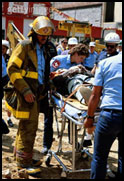|
What is a Unified Command?
Although a single Incident Commander normally handles the command function, an Incident Commnad System (ICS) organization may be expanded into a Unified Command (UC). The UC is a structure that brings together the "Incident Commanders" of all major organizations involved in the incident in order to coordinate an effective response while at the same time carrying out their own jurisdictional responsibilities. The UC links the organizations responding to the incident and provides a forum for these entities to make consensus decisions. Under the UC, the various jurisdictions and/or agencies and non-government responders may blend together throughout the operation to create an integrated response team.
The UC is responsible for overall management of the incident. The UC directs incident activities, including development and implementation of overall objectives and strategies, and approves ordering and releasing of resources. Members of the UC work together to develop a common set of incident objectives and strategies, share information, maximize the use of available resources, and enhance the efficiency of the individual response organizations.
| When should a UC be used? |
The UC may be used whenever multiple jurisdictions are involved in a response effort. These jurisdictions could be represented by:
 Geographic boundaries (such as two states, Indian Tribal Land); Geographic boundaries (such as two states, Indian Tribal Land);
- Governmental levels (such as local, state, federal);
- Functional responsibilities (such as fire fighting, oil spill, Emergency Medical Services (EMS));
- Statutory responsibilities (such as federal land or resource managers, responsible party under OPA or CERCLA); or
- Some combination of the above.
|
| Who is in a UC? |
Actual
UC makeup for a specific incident will be determined on
a case-by-case basis taking into account: (1) the specifics
of the incident; (2) determinations outlined in existing
response plans; or (3) decisions reached during the initial
meeting of the UC. The makeup of the UC may change as
an incident progresses, in order to account for changes
in the situation. The UC is a team effort, but to be effective,
the number of personnel should be kept as small as possible.
 Frequently, the first responders to arrive at the scene
of an incident are emergency response personnel from local
fire and police departments. The majority of local responders
are familiar with National Interagency Incident Management
System (NIIMS) ICS and are likely to establish one immediately.
As local, state, federal, and private party responders
arrive on-scene for multi-jurisdictional incidents, responders
would integrate into the ICS organization and establish
a UC to direct the expanded organization. Although the
role of local and state responders can vary depending
on state laws and practices, local responders will usually
be part of the ICS/UC. Frequently, the first responders to arrive at the scene
of an incident are emergency response personnel from local
fire and police departments. The majority of local responders
are familiar with National Interagency Incident Management
System (NIIMS) ICS and are likely to establish one immediately.
As local, state, federal, and private party responders
arrive on-scene for multi-jurisdictional incidents, responders
would integrate into the ICS organization and establish
a UC to direct the expanded organization. Although the
role of local and state responders can vary depending
on state laws and practices, local responders will usually
be part of the ICS/UC.
Members in the UC have decision-making authority for the
response. To be considered for inclusion as a UC representative,
the representative’s organization must:
- Have jurisdictional authority or functional responsibility
under a law or ordinance for the incident;
- Have an area of responsibility that is affected
by the incident or response operations;
- Be specifically charged with commanding, coordinating,
or managing a major aspect of the response; and
- Have the resources to support participation in the
response organization.
In addition, UC representatives
must also be able to:
- Agree on common incident objectives and priorities;
- Have the capability to sustain a 24-hour-a-day,
7-day-a-week commitment to the incident;
- Have the authority to commit agency or company resources
to the incident;
- Have the authority to spend agency or company funds;
- Agree on an incident response organization;
- Agree on the appropriate Command and General Staff
position assignments to ensure clear direction for
on-scene tactical resources;
- Commit to speak with “one voice” through the Information
Officer or Joint Information Center (JIC), if established;
- Agree on logistical support procedures; and
- Agree on cost-sharing procedures, as appropriate.
UC members bring their authorities
to the UC, as well as the resources to carry out their
responsibilities. The UC members may change as the response
transitions out of emergency response and into long-term
cleanup. Members in a UC have a responsibility to the
UC, and also to their agency or organization. These individuals
in the response management system do not relinquish agency
authority, responsibility, or accountability. The addition
of a UC to the ICS enables responders to carry out their
own responsibilities while working cooperatively within
one response management system. Under the NCP, the UC
may consist of a pre-designated On-Scene Coordinator (OSC),
the state OSC, the Incident Commander for the Responsible
Party (RP), and the local emergency response Incident
Commander.
 Generally, for spills on federal lands or resources, federal
land and resource managers have authority and responsibilities
comparable to those of local and state responders and
federally recognized Indian tribes. For this reason, federal
land and resource managers should be invited to participate
in the UC for spills on federal lands and resources under
their control. Similarly, for incidents on tribal lands
of federally recognized Indian tribes, a representative
from the Indian tribe must be invited to participate in
the UC. Generally, for spills on federal lands or resources, federal
land and resource managers have authority and responsibilities
comparable to those of local and state responders and
federally recognized Indian tribes. For this reason, federal
land and resource managers should be invited to participate
in the UC for spills on federal lands and resources under
their control. Similarly, for incidents on tribal lands
of federally recognized Indian tribes, a representative
from the Indian tribe must be invited to participate in
the UC. |
| How does the UC make decisions? |
 The
UC is not "decision by committee." The principals
are there to command the response to an incident. Time
is of the essence. The UC should develop synergy based
on the significant capabilities that are brought by the
various representatives. There should be personal acknowledgement
of each representative's unique capabilities, a shared
understanding of the situation, and agreement on the common
objectives. With the different perspectives on the UC
comes the risk of disagreements, most of which can be
resolved through an understanding of the underlying issues.
Contentious issues may arise, but the UC framework provides
a forum and a process to resolve problems and find solutions.
If situations arise where members of the UC cannot reach
consensus, the UC member representing the agency with
primary jurisdiction over the issue would normally be
deferred to for the final decision. If this approach does
not work, the Regional Response Team (RRT) may be called
on to serve as a forum where differences can be thoroughly
discussed and to assist in resolving the disagreement. The
UC is not "decision by committee." The principals
are there to command the response to an incident. Time
is of the essence. The UC should develop synergy based
on the significant capabilities that are brought by the
various representatives. There should be personal acknowledgement
of each representative's unique capabilities, a shared
understanding of the situation, and agreement on the common
objectives. With the different perspectives on the UC
comes the risk of disagreements, most of which can be
resolved through an understanding of the underlying issues.
Contentious issues may arise, but the UC framework provides
a forum and a process to resolve problems and find solutions.
If situations arise where members of the UC cannot reach
consensus, the UC member representing the agency with
primary jurisdiction over the issue would normally be
deferred to for the final decision. If this approach does
not work, the Regional Response Team (RRT) may be called
on to serve as a forum where differences can be thoroughly
discussed and to assist in resolving the disagreement.
The bottom line is that the UC has certain responsibilities
as noted above. Failure to provide clear objectives for
the next operational period means that the Command function
has failed. While the UC structure is an excellent vehicle
(and the only nationally recognized vehicle) for coordination,
cooperation, and communication, the duly authorized representatives
must make the system work successfully. A strong command
– a single Incident Commander or a UC – is essential to
an effective response.
Each UC member may assign Deputy Incident Commander(s)
to assist in carrying out Incident Commander responsibilities.
UC members may also be assigned individual legal and administrative
support from their own organizations.
|
| What if your agency is not a part of the UC? |
 To
ensure that your organization’s concerns or issues are
addressed if your agency is not represented within the
UC, your organization should assign representatives to: To
ensure that your organization’s concerns or issues are
addressed if your agency is not represented within the
UC, your organization should assign representatives to:
- Serve as an agency or company representative;
- Provide input to your agency or company representative,
who has direct contact with the Liaison Officer;
- Provide stakeholder input to the Liaison Officer
(for environmental, economic, or political issues);
- Serve as a Technical Specialist in the appropriate
section; and/or
- Provide input to a UC member.
|
|
|
|
|
|
|
|